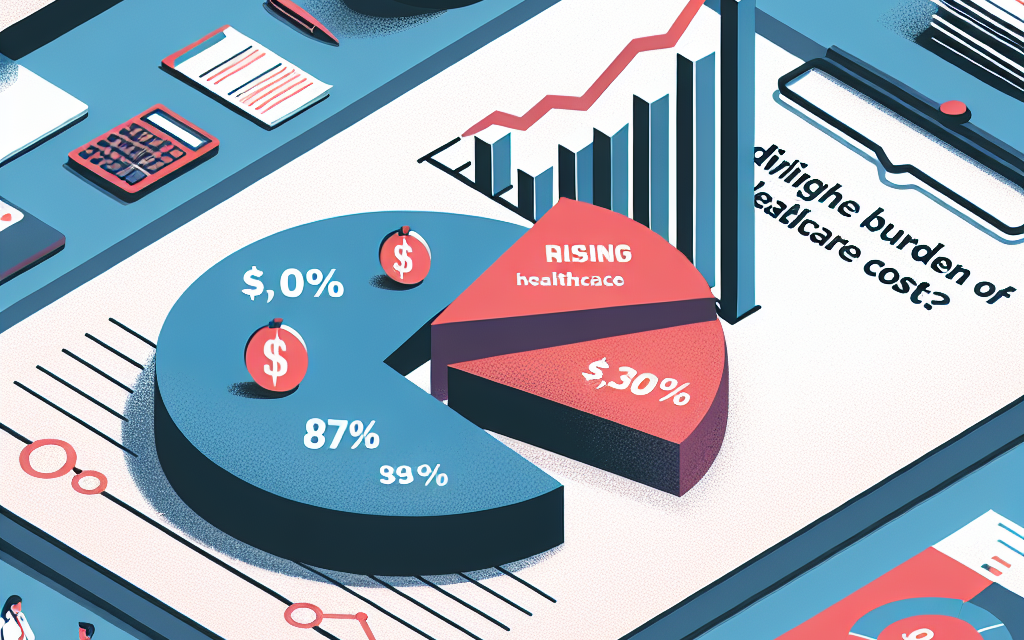Employer Survey Suggests Workers May Bear the Brunt of Increasing Healthcare Costs

In recent years, the landscape of healthcare costs has been shifting dramatically, with significant implications for both employers and employees. A recent survey indicates that workers may increasingly bear the brunt of these rising costs. This article delves into the complexities of this issue, exploring the factors driving healthcare cost increases, the impact on employees, and potential strategies for mitigation. Through detailed analysis and case studies, we aim to provide a comprehensive understanding of this critical topic.
Understanding the Rising Healthcare Costs
The cost of healthcare in the United States has been on an upward trajectory for decades. This section explores the underlying factors contributing to this trend, providing a foundation for understanding the broader implications for employers and employees.
Factors Driving Healthcare Cost Increases
Several factors contribute to the rising costs of healthcare, each playing a significant role in the overall increase. These include:
- Technological Advancements: While new medical technologies can improve patient outcomes, they often come with high price tags. The development and implementation of cutting-edge treatments and diagnostic tools drive up costs.
- Aging Population: As the population ages, the demand for healthcare services increases. Older adults typically require more medical care, leading to higher overall healthcare expenditures.
- Chronic Diseases: The prevalence of chronic diseases such as diabetes, heart disease, and obesity has risen, necessitating ongoing and often expensive treatment.
- Administrative Costs: The complexity of the U.S. healthcare system results in significant administrative expenses, which contribute to overall cost increases.
- Pharmaceutical Prices: The cost of prescription drugs continues to rise, driven by factors such as research and development expenses and market exclusivity.
These factors, among others, create a challenging environment for managing healthcare costs, impacting both employers and employees.
The Role of Insurance Companies
Insurance companies play a crucial role in the healthcare cost equation. Their policies and practices can significantly influence the cost burden on employers and employees. Key aspects include:
- Premium Increases: Insurance companies often raise premiums to cover rising healthcare costs, directly affecting both employers and employees.
- Cost-Sharing Mechanisms: Insurers may implement cost-sharing mechanisms such as higher deductibles and copayments, shifting more financial responsibility to policyholders.
- Network Restrictions: Insurers may limit provider networks to control costs, potentially reducing access to preferred healthcare providers for employees.
Understanding the role of insurance companies is essential for comprehending the broader dynamics of healthcare cost increases.
Impact on Employers
Employers face significant challenges in managing rising healthcare costs. These challenges include:
- Increased Financial Burden: Employers often absorb a substantial portion of healthcare cost increases, impacting their bottom line.
- Competitive Pressures: Rising healthcare costs can affect an employer’s ability to offer competitive compensation packages, influencing talent acquisition and retention.
- Administrative Complexity: Managing healthcare benefits becomes increasingly complex as costs rise, requiring more resources and expertise.
Employers must navigate these challenges while balancing the needs of their workforce and their financial objectives.
Case Study: A Mid-Sized Manufacturing Company
To illustrate the impact of rising healthcare costs on employers, consider the case of a mid-sized manufacturing company. This company experienced a 15% increase in healthcare premiums over three years, prompting a reevaluation of their benefits strategy. Key actions included:
- Exploring Alternative Insurance Providers: The company sought competitive bids from multiple insurers to identify cost-effective options.
- Implementing Wellness Programs: To mitigate costs, the company introduced wellness programs aimed at improving employee health and reducing claims.
- Adjusting Cost-Sharing Arrangements: The company revised its cost-sharing arrangements, increasing employee contributions to premiums and out-of-pocket expenses.
This case study highlights the proactive measures employers may take to address rising healthcare costs while maintaining employee satisfaction.
The Impact on Employees
As healthcare costs rise, employees increasingly bear the financial burden. This section examines the implications for workers, including changes in benefits, financial stress, and access to care.
Changes in Employee Benefits
Employers often respond to rising healthcare costs by adjusting employee benefits. Common changes include:
- Higher Premiums: Employees may face higher premiums, reducing their take-home pay.
- Increased Deductibles and Copayments: Cost-sharing mechanisms such as higher deductibles and copayments shift more financial responsibility to employees.
- Reduced Coverage Options: Employers may limit coverage options or restrict access to certain providers to control costs.
These changes can significantly impact employees’ financial well-being and access to necessary healthcare services.
Financial Stress and Its Consequences
The financial burden of rising healthcare costs can lead to significant stress for employees. Consequences include:
- Increased Debt: Employees may incur debt to cover medical expenses, leading to financial instability.
- Delayed or Foregone Care: Financial constraints may cause employees to delay or forego necessary medical care, potentially worsening health outcomes.
- Reduced Job Satisfaction: Financial stress can negatively impact job satisfaction and overall well-being, affecting productivity and morale.
Addressing the financial stress associated with rising healthcare costs is crucial for maintaining a healthy and productive workforce.
Access to Care and Health Outcomes
Rising healthcare costs can also affect employees’ access to care and health outcomes. Key issues include:
- Limited Provider Networks: Employees may face restrictions on their choice of healthcare providers, impacting continuity of care.
- Delayed Treatment: Financial barriers may lead to delayed treatment, resulting in more severe health issues and higher long-term costs.
- Preventive Care Utilization: Cost concerns may deter employees from seeking preventive care, increasing the risk of chronic conditions.
Ensuring access to affordable and timely healthcare is essential for promoting positive health outcomes among employees.
Case Study: A Retail Employee’s Experience
Consider the experience of a retail employee facing rising healthcare costs. This employee saw their premiums increase by 20% over two years, leading to financial strain. Key challenges included:
- Budget Constraints: The employee struggled to balance healthcare expenses with other financial obligations, leading to increased debt.
- Delayed Medical Care: Financial concerns prompted the employee to delay necessary medical care, resulting in worsened health conditions.
- Job Dissatisfaction: The financial stress contributed to reduced job satisfaction and increased absenteeism.
This case study underscores the real-world impact of rising healthcare costs on employees and the importance of addressing these challenges.
Strategies for Mitigating Healthcare Cost Increases
While rising healthcare costs present significant challenges, there are strategies that employers and employees can implement to mitigate these increases. This section explores potential solutions and best practices.
Employer-Led Initiatives
Employers can take proactive steps to manage healthcare costs while supporting employee well-being. Key initiatives include:
- Wellness Programs: Implementing wellness programs can improve employee health and reduce healthcare claims, leading to cost savings.
- Telemedicine Services: Offering telemedicine services can enhance access to care and reduce costs associated with in-person visits.
- Value-Based Insurance Design: Employers can adopt value-based insurance designs that incentivize high-value care and preventive services.
These initiatives can help employers manage costs while promoting a healthier workforce.
Employee Engagement and Education
Engaging and educating employees about their healthcare options is crucial for cost management. Strategies include:
- Health Literacy Programs: Providing health literacy programs can empower employees to make informed healthcare decisions.
- Transparent Communication: Employers should communicate clearly about benefits changes and cost-sharing arrangements to avoid confusion and build trust.
- Incentives for Preventive Care: Offering incentives for preventive care can encourage employees to prioritize their health and reduce long-term costs.
By fostering employee engagement and education, employers can promote better health outcomes and cost management.
Policy and Regulatory Considerations
Policy and regulatory changes can also play a role in addressing rising healthcare costs. Key considerations include:
- Healthcare Reform: Comprehensive healthcare reform can address systemic issues contributing to cost increases, such as administrative inefficiencies and pharmaceutical pricing.
- Price Transparency: Policies promoting price transparency can empower consumers to make cost-effective healthcare choices.
- Incentives for Innovation: Encouraging innovation in healthcare delivery and payment models can lead to more efficient and cost-effective care.
Policy and regulatory changes can create a more sustainable healthcare system that benefits both employers and employees.
Case Study: A Tech Company’s Approach
Consider the approach of a tech company that successfully managed rising healthcare costs through innovative strategies. Key actions included:
- Data-Driven Decision Making: The company used data analytics to identify cost drivers and implement targeted interventions.
- Partnerships with Healthcare Providers: Collaborating with healthcare providers allowed the company to negotiate favorable rates and improve care coordination.
- Employee Wellness Initiatives: The company invested in comprehensive wellness initiatives, resulting in improved employee health and reduced claims.
This case study demonstrates the potential for innovative strategies to effectively manage healthcare costs while supporting employee well-being.
The Future of Healthcare Costs and Workforce Implications
As healthcare costs continue to rise, understanding the future implications for the workforce is essential. This section explores potential trends and their impact on employers and employees.
Trends in Healthcare Cost Management
Several trends are emerging in healthcare cost management, including:
- Increased Focus on Value-Based Care: The shift towards value-based care emphasizes quality and outcomes, potentially reducing costs over time.
- Advancements in Telehealth: The expansion of telehealth services offers opportunities for cost savings and improved access to care.
- Personalized Medicine: Advances in personalized medicine may lead to more targeted and cost-effective treatments.
These trends have the potential to reshape the healthcare landscape and influence cost management strategies.
Workforce Implications
The future of healthcare costs will have significant implications for the workforce. Key considerations include:
- Talent Acquisition and Retention: Employers must balance healthcare costs with competitive compensation packages to attract and retain talent.
- Employee Health and Productivity: Rising healthcare costs can impact employee health and productivity, necessitating proactive management strategies.
- Workplace Flexibility: Employers may need to offer flexible work arrangements to accommodate employees’ healthcare needs and preferences.
Understanding these implications is crucial for employers seeking to navigate the evolving healthcare landscape.
Case Study: A Financial Services Firm’s Strategy
Consider the strategy of a financial services firm that successfully navigated rising healthcare costs while supporting its workforce. Key actions included:
- Comprehensive Benefits Package: The firm offered a comprehensive benefits package that balanced cost management with employee satisfaction.
- Flexible Work Arrangements: Flexible work arrangements allowed employees to prioritize their health and well-being.
- Investment in Employee Health: The firm invested in employee health initiatives, resulting in improved productivity and reduced healthcare claims.
This case study highlights the importance of strategic planning and investment in employee well-being for managing healthcare costs effectively.
Conclusion
The rising cost of healthcare presents significant challenges for both employers and employees. As this article has explored, understanding the factors driving these increases, the impact on workers, and potential strategies for mitigation is crucial for navigating this complex landscape. Employers must balance cost management with employee well-being, while employees must navigate changes in benefits and financial stress. By implementing innovative strategies and fostering collaboration between stakeholders, it is possible to address the challenges of rising healthcare costs and promote a healthier, more productive workforce. As the healthcare landscape continues to evolve, staying informed and proactive will be essential for achieving sustainable solutions.





